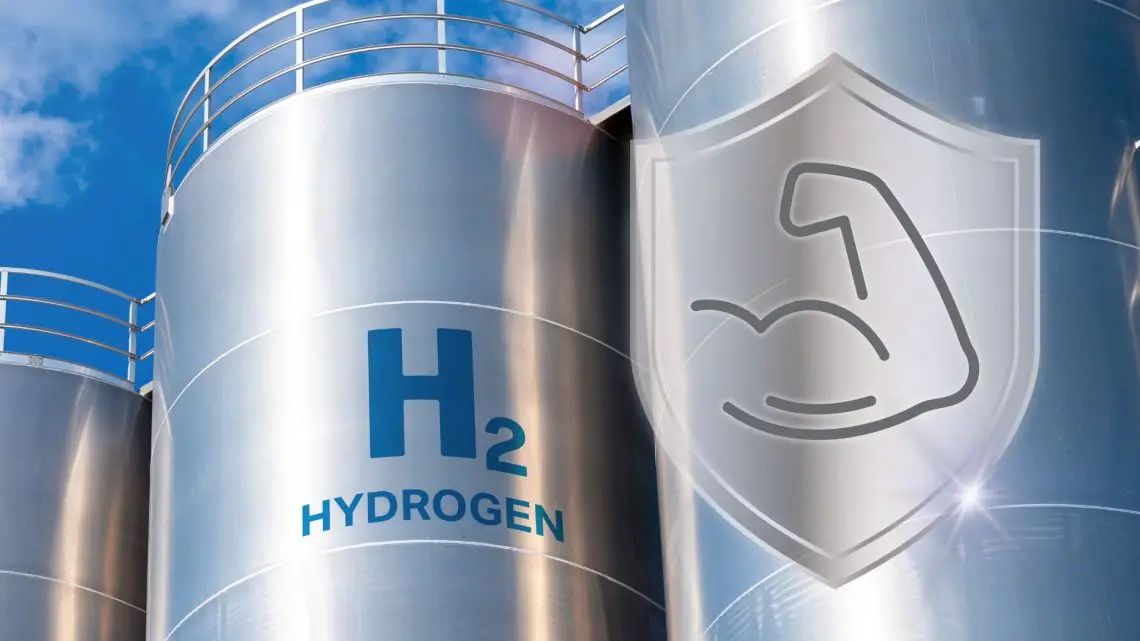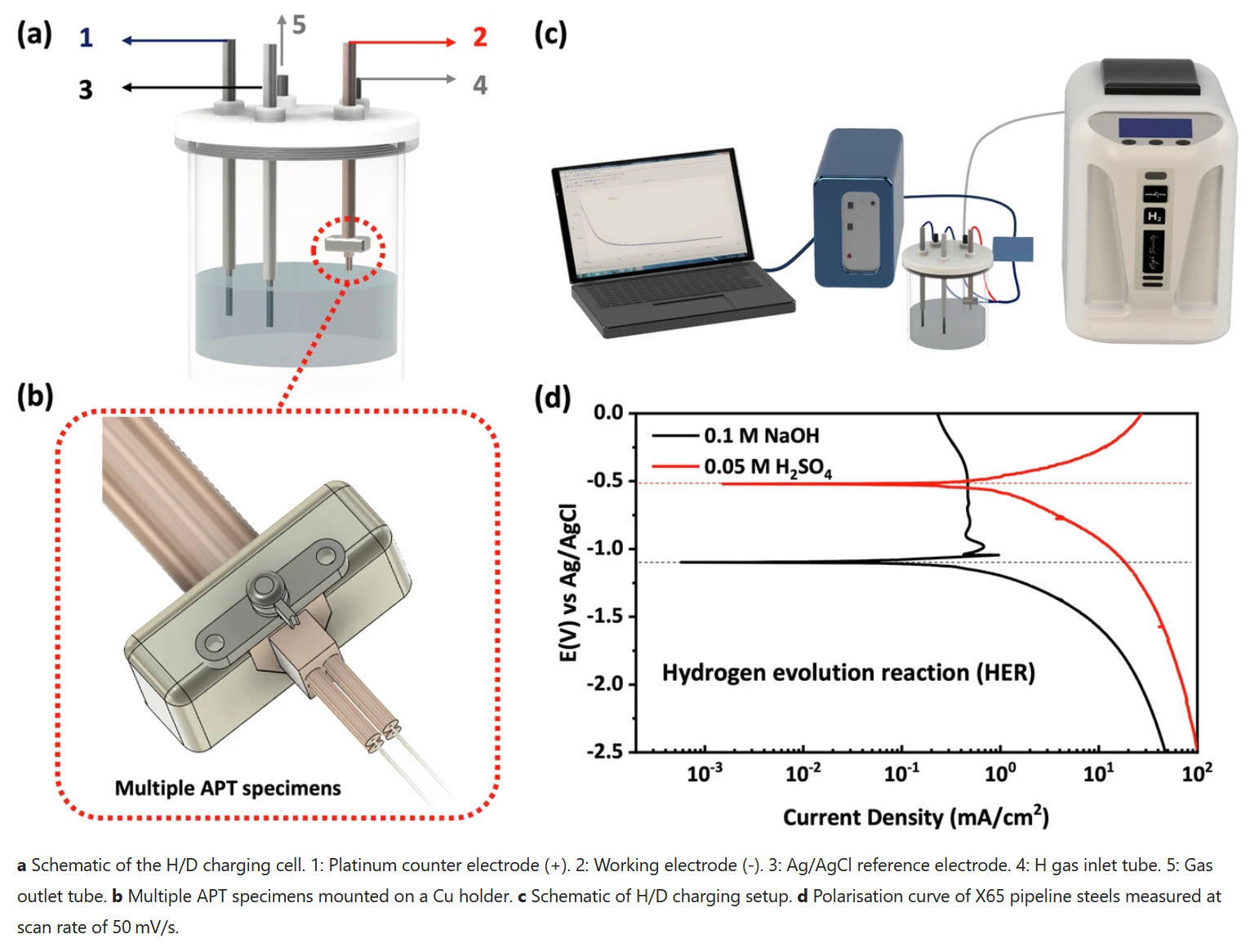
The Future of Hydrogen Storage: Discoveries in Steel Durability
November 23, 2024 1 By Alicia MooreUnlocking the Secrets of Hydrogen Storage: A New Era for Hydrogen Energy
In a groundbreaking study, scientists have utilized atom probe tomography (APT) to explore hydrogen embrittlement in X65 pipeline steel, a material pivotal for hydrogen storage and transportation. This research offers vital insights that could revolutionize our approach to safe and efficient hydrogen energy systems.
Understanding Atom Probe Tomography (APT)
APT is a cutting-edge technology that allows researchers to observe and quantify hydrogen and its isotope, deuterium, at the atomic scale within materials. This high-resolution tool provides a detailed map of where hydrogen atoms settle, offering unprecedented insights into hydrogen embrittlement—a phenomenon where hydrogen weakens materials like steel.

Electrochemical H/D charging setup – Image Credit Nature
Experimentation and Methodology
The study involved a series of meticulous experiments to understand hydrogen behavior in X65 steel:
-
Use of Deuterium as a Proxy:
- Deuterium, a heavier isotope of hydrogen, was employed to differentiate between hydrogen introduced during specimen preparation and that naturally present in the material.
- This approach enhances the accuracy of measurements by minimizing contamination from the instrument environment.
-
Ambient Transfer Technique:
- Unlike traditional methods requiring cryogenic conditions, this study demonstrated that reliable APT measurements could be achieved at ambient temperatures.
- This makes the technique more practical and accessible for broader applications.
-
Detailed Workflow Analysis:
- Various workflows were examined, including different specimen preparation methods and electrochemical charging conditions.
- Insights gained from these analyses help identify effective strategies for hydrogen and deuterium charging.
Key Findings and Implications
The study revealed several critical insights into hydrogen storage and embrittlement:
-
Hydrogen Accumulation and Movement:
- APT allowed researchers to see which parts of the steel attract hydrogen and how it moves around, crucial for designing more resistant materials.
-
Material Design and Surface Treatments:
- Data from APT studies aid in designing steel alloys that minimize hydrogen accumulation, potentially altering compositions to include hydrogen-trapping elements.
- Surface treatments, such as coatings, can be applied to reduce hydrogen penetration.
-
Microstructural Engineering:
- By controlling grain size and phase distribution, the steel’s microstructure can be refined to resist hydrogen movement.
Distinguishing Features of the APT Study on Hydrogen Embrittlement
This study on hydrogen embrittlement in X65 pipeline steel stands apart from similar research due to its innovative methodologies and comprehensive approach. Here’s what makes this study unique:
-
Deuterium as a Proxy for Hydrogen:
- By using deuterium, a stable isotope of hydrogen, this study addresses the common challenge of distinguishing between hydrogen introduced during sample preparation and that which is naturally present. This novel approach improves the accuracy of quantifying hydrogen in steel, providing more reliable data than traditional methods.
-
Ambient Transfer Technique:
- Unlike studies that require cryogenic conditions for specimen transfer, this research demonstrates that accurate atom probe tomography (APT) measurements can be achieved under ambient temperature conditions. This makes the technique more accessible and practical for a wider range of applications, eliminating the need for complex and costly cryo-transfer setups.
-
Comprehensive Workflow Analysis:
- The study meticulously examines various workflows, including specimen preparation and electrochemical charging conditions. By testing different methods, researchers identified the most effective strategies for hydrogen and deuterium charging. This detailed analysis offers a robust framework for future research and material development, setting a new standard in the field.
-
Statistical Rigor and Confidence:
- Through careful comparison of charged and uncharged conditions, the study provides statistically significant evidence of hydrogen and deuterium trapping. This level of statistical rigor ensures that the findings are not only innovative but also reliable and reproducible.
These distinctive elements not only advance the understanding of hydrogen embrittlement but also offer practical solutions for developing hydrogen-resistant materials. This study’s methodological innovations and thorough analyses contribute significantly to the field, providing a foundation for safer and more efficient hydrogen energy systems.
Conclusion: Bridging Research to Real-World Applications
The study on atom probe tomography (APT) for analyzing hydrogen embrittlement in X65 pipeline steel has unveiled crucial insights that hold the potential to revolutionize hydrogen storage and transportation. By employing innovative methodologies such as using deuterium as a proxy and ambient transfer techniques, researchers have laid a robust foundation for the development of hydrogen-resistant materials.
These findings can be directly implemented in creating more resilient steel alloys by designing compositions that minimize hydrogen accumulation and employing surface treatments to act as barriers against hydrogen penetration. Furthermore, refining the microstructure of these materials by controlling grain size and phase distribution could further inhibit hydrogen mobility, enhancing the durability and safety of hydrogen storage systems.
The broader implications of this research extend to the adoption of hydrogen as a viable clean energy source. By ensuring that materials used in hydrogen infrastructure are resistant to embrittlement, we can safely scale up hydrogen energy systems, supporting a transition to more sustainable energy solutions.
About The Author
Alicia Moore's dedication to sustainable energy products goes beyond her writing. She actively seeks out new ways to live more sustainably, and encourages others to do the same. Her commitment to eco-friendly living is evident in her daily life, and she is always looking for ways to reduce her impact on the environment. What sets Alicia apart as a writer is her ability to communicate complex topics in a way that is accessible to everyone. Her passion for renewable energy is contagious, and her writing inspires readers to consider the ways in which they can make a positive impact on the planet. Ultimately, Alicia's work is driven by a desire to create a more sustainable and equitable world, and her writing serves as a powerful tool for achieving this goal.
1 Comment
Leave a Reply Cancel reply
This site uses Akismet to reduce spam. Learn how your comment data is processed.




 With over 15 years of reporting hydrogen news, we are your premier source for the latest updates and insights in hydrogen and renewable energy.
With over 15 years of reporting hydrogen news, we are your premier source for the latest updates and insights in hydrogen and renewable energy.
* Material Design and Surface Treatments:
* Data from APT studies aid in designing steel alloys that minimize hydrogen accumulation, potentially altering compositions to include hydrogen-trapping elements.
* Surface treatments, such as coatings, can be applied to reduce hydrogen penetration.
* Microstructural Engineering:
* By controlling grain size and phase distribution, the steel’s microstructure can be refined to resist hydrogen movement.